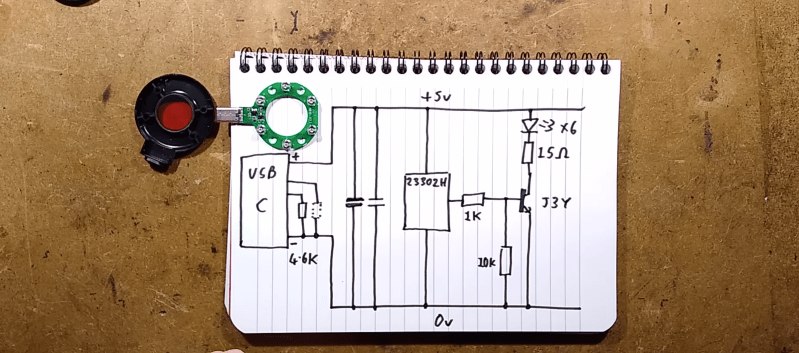If you’ve ever been concerned about privacy in a rental space or hotel room, you might have considered trying one of the many “spy camera detectors” sold online. In the video after break [Big Clive], tears one down and gives us an in-depth look at how these gadgets actually work, and their limitations.
Most detector follow the same basic design: a ring of LEDs through which the user inspects a room, looking for reflections indicating a potential hidden camera. Although this device can help spot a camera, it’s not entirely foolproof. The work best when you’re close to the center of a camera’s field of view, and some other objects, like large LEDs can produce similar reflections
The model examined in this video takes things one step further by adding a disc of dichroic glass. Coated with a metallization layer close to the wavelength of the LEDs, it effectively acts a bandpass filter, reducing reflections from other light sources. [Big Clive] also does his customary reverse-engineering of the circuit, which is just a simple flasher powered by USB-C.
[Big Clive]’s teardowns are always an educational experience, like we’ve seen in his videos on LED bulb circuits and a fake CO2 sensor.

















So the “Anti-camer detector” is a reflective surface detector. You could have use any light for this it would have acted the same.
No, that isn’t how it works. Read the whole thing without stopping at a key word and you’ll eventually understand.
Could’ve used a 555.
Or EMP generator.
I wonder if you could set up an IR detector and turn off the lights, assuming the hidden camera has night mode and some IR LEDs for illumination.
A long time ago I thought of an idea for a (not hidden) camera that uses AI to only record when humans are not in the room. But, you’d have to convince the legal system that it doesn’t break the privacy laws. (The use case was for an Airbnb owner to be able to identify stolen or broken items in the video recording)
an IR detector, like a camera without an IR filter?
My phone night camera is great at catching IR sources…
no need to toy with IR filter removal or such when one of the multiple camera already ship with no ir filters :)
Maybe I should just bring the baby monitor. That’s not a bad idea actually.
The *censored* record everything, and claim that the sacristy of the fourth amendment is in tact as long as a human never accesses the recording. They claim that it is totally fine for machines to store, process the recordings and negatively or positively flag the recordings – as long as a human only looks at the flag raised and metadata, never the recording. But good luck convincing the legal system, when caught with recording that you should not have.
hint: No Such Agency
Your tinfoil hat is leaking.
Tinfoil hats are so 1990’s. I wear a silver mesh balaclava with a gold mesh inner lining (because Au is the best when it comes to reflecting IR – and with so much metal on my head I need to keep all the heat that I can).
Watch this (no one would ever lie to congress) https://www.youtube.com/watch?v=QwiUVUJmGjs
That’s a bad idea. It’d also record when there’s humans doing things which aren’t in the training set, which is probably the worst stuff to record privacy-wise.
Far simpler to just take a before and after shot. You can even remove the camera, just place it back in the same spot between bookings.
Well luckily there’s no shortage of footage to train for *that* on. ;)
Don’t need AI…just an inexpensive human detection radar
They actually really needed because of the many cases of air b&b rentals with hidden cameras witch violating the privatsphere.
In my ABB I only have cams in the bedrooms and bathrooms.
:) /s
On which platforms don you upload? :-)
If there’s an IR light on the offending camera for night viewing, then my cell phone does a good job of seeing the IR. I sometimes have to check remote control operation, and Cell phones do show the IR light emitted by remote controls. The other way would be to try to detect the clock freq on the little controller of the Camera, or other freqs emitted by other ckts of the camera.
I remember reading some years ago of tech being developed in Europe that actively scan an audience in theaters for cameras and blind them with pulses of IR. Never heard how it turned out.
Wondering how would it not cause trouble with biological cameras, i.e., eyes?
It wouldn’t literally blind the cameras; just that it would emit enough IR to confuse their automatic exposure system and cause them to reduce the exposure enough to be unable to see the actual performance.
There’s no need to detect the cameras. It’s enough to flood-flash (or flash patterns of) IR light on the screen randomly all the time. Humans won’t see the IR light and most cameras will deliver footage that’s all over the place exposure-wise and maybe even show the projected patterns in the footage (eg. a cinema id watermark and a date of projection). If there are no cameras, no harm done anyway, except for some electricity wasted and wear+tear on the IR emitter
The military use something similar – they sweep the surroundings with a beam and it shows up optics that are aimed their way.
Of course, if you wanted to confuse them, you’s just leave cheap shitty lenses in every bush around the military compound and overload them with false positives…
I use my meta quest 2 in passthrough to look for IR devices. Works so far.